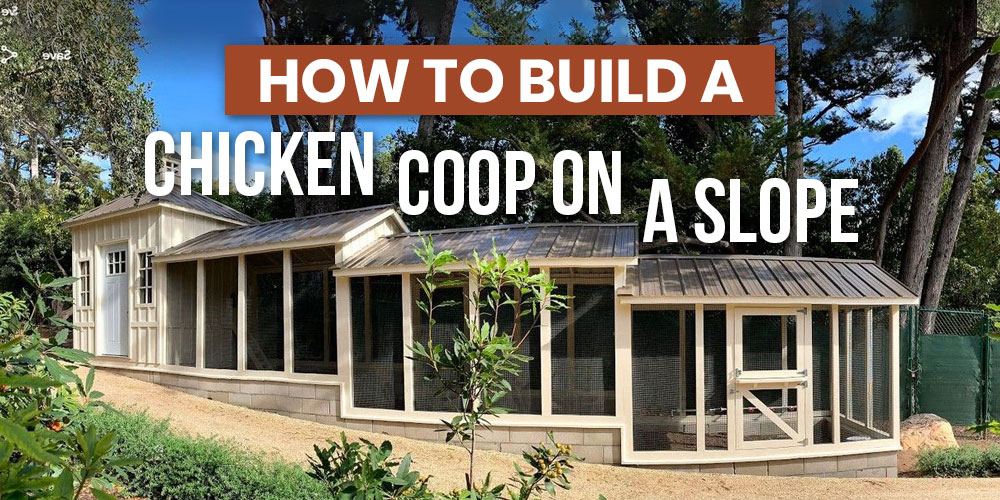
NAVIGATION
Living as a homesteader in a landscape where hills and mountains abound, it didn’t take me long to figure out how to build a chicken coop on a slope. Sloping or even steep landscapes don’t have to stand in the way of safe housing, hatching, or raising happy chickens. Actually, it allows you to consider creative designs and take advantage of your rolling landscape.

Hi, I’m Ryan
I’ve seen and helped many people build chicken coops on slopes and hillsides with great success. As long as you plan ahead and follow these helpful hints along the way, a slope or hill is an excellent area for your chickens to enjoy living.

Can I Build A Chicken Coop On A Slope?

Yes, you can build a chicken coop on a slope. While building a chicken coop on sloping terrain is challenging, don’t let it scare you! All you need is the proper mindset, the right materials, and some thoughtful planning.
 In fact, there are many upsides to building a chicken coop on a slope. A level coop raised up on blocks creates a perfectly shaded and safe area for your chickens that they can use to cool off on a hot day and stay dry during inclement weather. The slope also lets water drain downhill so puddles don’t muck up your chickens’ space.
In fact, there are many upsides to building a chicken coop on a slope. A level coop raised up on blocks creates a perfectly shaded and safe area for your chickens that they can use to cool off on a hot day and stay dry during inclement weather. The slope also lets water drain downhill so puddles don’t muck up your chickens’ space.
Surprising as it may seem, a chicken coop on a slope comes with a lot of possibilities. Slope cooping provides the opportunity for incorporating fun designs like raised beds or connecting the chicken run to a garden.
Most of the planning for a hillside chicken coop will revolve around an effective and innovative design. The design helps you determine the minimum angle of your ramp, the ramp’s steepness, and what materials you need to properly support the structure.
How To Build A Chicken Coop On A Slope

Building a chicken coop on a slope is all about creating the best environment for your chickens to thrive on a hillside. What I did first was choose a location that allowed me to maintain coop hygiene and provide protection for my chickens. When building a chicken coop on a hillside or sloped terrain, it’s important to build the coop on high ground to avoid waste runoff, flooding, or water buildup.
Pick The Perfect Spot For Your Hillside Chicken Coop
A well-shaded chicken coop and run will result in happier, more comfortable chickens. This is because it’s easier to keep your coop warm in the wintertime than it is to try and cool it down in the summer, especially in temperate climates.
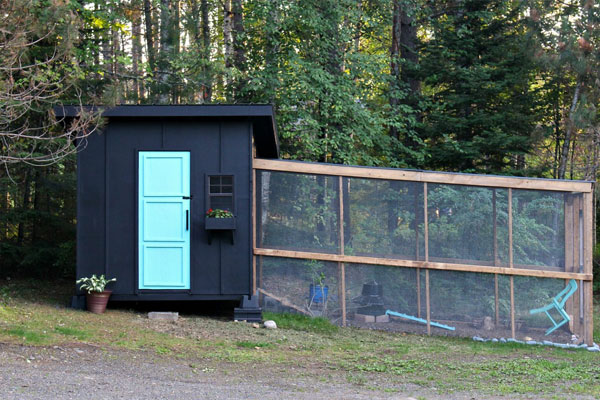
Create A Level Base For Your Chicken Coop On A Slope
Thinking about the base of the coop itself is an important step. The entire structure may be on a slope, but the vertically stationed coop needs its floor resting on a solid, horizontally level foundation.
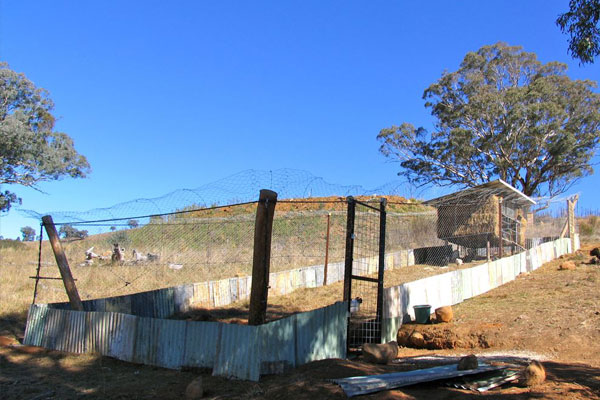 The piers, pillars, or solid foundation that support your chicken coop base on the lower side of the hill will need to be tall enough to compensate for the height difference the ground slope creates. This requires some careful measurement, the use of a reliable level, and possibly some trial and error to find the right balance on an uneven terrain.
The piers, pillars, or solid foundation that support your chicken coop base on the lower side of the hill will need to be tall enough to compensate for the height difference the ground slope creates. This requires some careful measurement, the use of a reliable level, and possibly some trial and error to find the right balance on an uneven terrain.
I generally recommend using wooden posts to lift chicken coops on high or steep slopes, and something simple like concrete deck blocks or cinder blocks for low slopes. Blocks are perfect for adjusting small height differences, but wooden piers allow you to be more precise. Make sure your base is level and firm before going any further.
The framework for your base and walls can be built using pressure treated 2” x 4” wood, topped with sheets of pressure-treated plywood.
Create A Sloped Roof
When you’re building a chicken coop, especially one on a hill or mountainside, a sloped roof is absolutely essential. You should match the slope of your roof to the slope of the hill, so snow or rain will roll right off. Metal roofing works great for chicken coops, as it’s both sturdy and weather resistant.
The slope of the roof that covers your run should match the slope of the land as closely as possible. This will help keep measurements consistent as you build out the frame and protective fencing around the run. I used the same metal roofing for my hen’s run as I did for the coop to be cost-efficient.
“Make sure the framed walls of your coop are cut to the same angle as your roof for a seamless fit.”
A Ramp So Chickens Can Get In And Out Of Their Hillside Coop
If your coop door is over a foot higher than the ground, a simple solution is to build a ramp for easy access and to avoid injury among your flock.
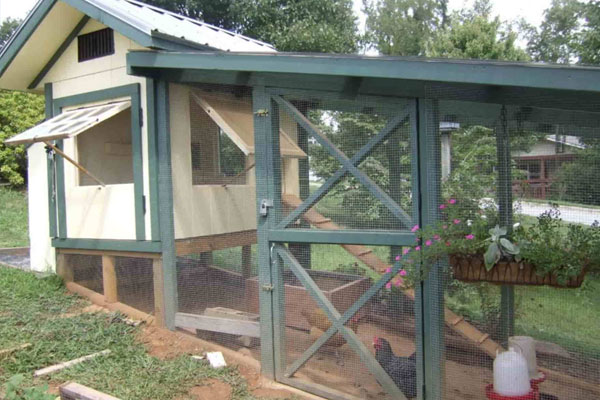
Safely Seal Your Hillside Chicken Coop
Plain wire for homestead fences might help keep your hens in a specific area, but hawks and foxes can easily break through. For added protection, I also secure locks on my chicken coop doors and windows to keep my chickens safely inside at night.
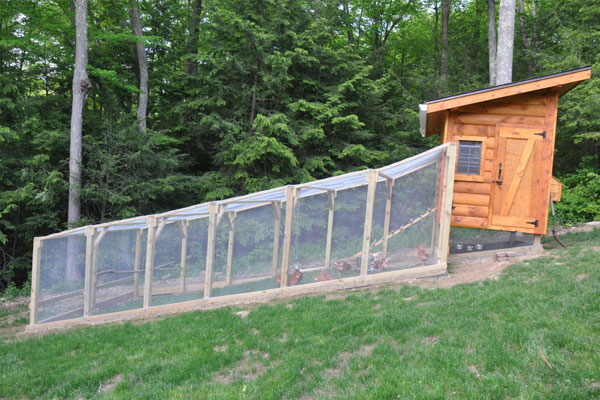
“Foundations with hardware mesh or solid, concrete bases keep vermin and predators away by fully protecting access to the chicken run.”
Choose The Right Materials For A Chicken Coop On A Slope

At the same time, your building and finishing materials should align with your personal preferences. I don’t mind spending a few extra bucks if it means the material is durable and meant to last.
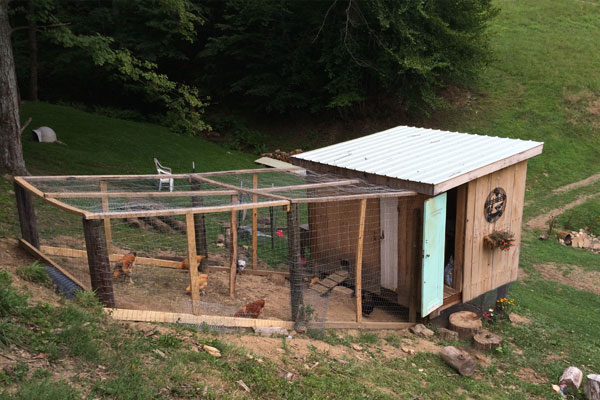
FAQs For Building A Chicken Coop On A Slope

If you’re just getting started in this adventure, chickens, coops, and runs bring up lots of questions. Luckily, I have some answers!
How Steep Is Too Steep For A Chicken Ramp?
If your ramp is steeper than 30 degrees, place cleats every four to six inches. This prevents your chickens from sliding down the ramp and getting hurt.
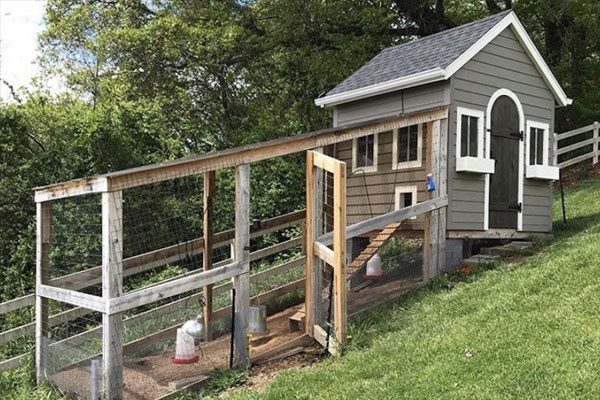
Can I Get My Chickens To Walk Up Ramps?
Some farmers or homesteaders also place food on the ramps to encourage their use — you can train chickens to use the ramp by leaving a trail of treats like bugs or worms for them to follow.
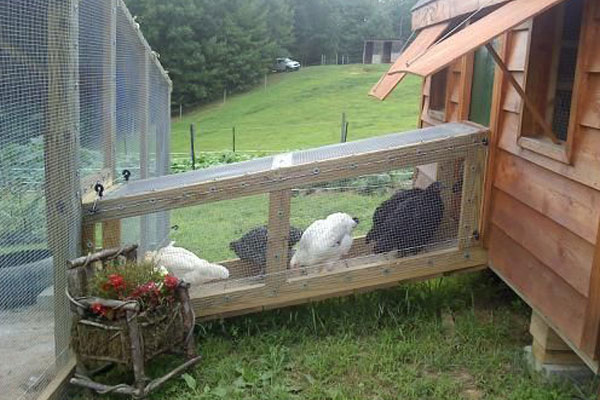
How Cold Is Too Cold For Chickens?
Chickens tolerate cold temperatures quite well, which is good news if you’re building a chicken coop on a slope in the mountains or in a colder climate. In fact, chicken experts say they do well until the temperature inside their coop falls to -20 degrees Fahrenheit, so as long as you can keep temps above that, you’ll be in good shape.
On the other hand, since chickens don’t like to walk on snow, ice, or muddy ground, placing outdoor perches for them to stand on will help get the chickens outside in cold weather. This also gives your chickens a place to rest and feel more comfortable whether it’s hot or cold.
Does A Chicken Run On A Slope Need To Be On Grass?
Concrete is safe because it keeps burrowing predators outside where they belong. It’s also low maintenance and lasts longer than wood floors because it doesn’t rot.
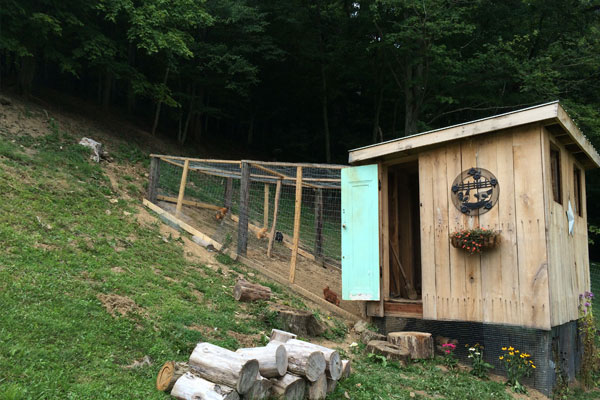
“Your chicken coop can have a variety of “floors” including straw, concrete, or plywood.”
Downsides To Building A Chicken Coop On A Slope?
The only downside is an increased risk of predators getting after your chickens. That’s why you want to put a lot of time and effort into creating a decent foundation that raccoons and other predators can’t get into.
If you’re learning how to build a chicken coop on a slope, embrace the challenge! It’s a great idea and innovative use of space. After all, chickens need a safe and dry place to roost and lay their eggs. A hillside provides a great option that helps to protect your chickens from predators and provides shade on a hot day, along with good ventilation and drainage.
Your Turn!
- What steps will you take to get your sloped land ready for a coop?
- Is your biggest concern climate, predators, or both?




Leave a Reply